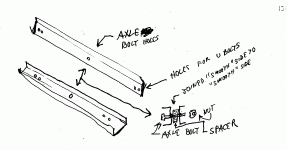Sorry, I tried to reply to your "private message with a private message B U T couldn't figure out how to send an attachment so I'm back here.
FEL attachment to stand poles in holes
Ain't it amazin', what seems like the most lucid and cogent description to the originator
seems like gobledygook to his audience, and frequently to him too the next day. Anyway,
I'll have a bash at describing it again.
Let me tell you what it looks like when it is done and then try to say how to build it.
Knowing the goal and not just the intermediate steps should help. (bear with me I am
not the world's best describer but here goes...)
In operation, with a post being held by the apparatus, the post should be able to be
spun like an airplane propellor if it is ballanced. Your FEL needs to be able to lift as high
as about 1/2 the length of the post. What you are making is a fixture that clamps to the
FEL blade with two "C" clamps and to the post with two more "C" clamps. Except for the
distance between the "C" clamps, the two halves of the apparatus, 1. the part affixed to
the blade and 2. the part clamped to the post are similar. The "C" clamps are different
distances apart on the two pieces so the rotating part's "C" clamps don't hit the
stationary part's "C" clamps.
The "stationary part" is made by clamping two "C" clamps onto a channel iron by means
of a couple "U" bolts through holes drilled in the channel iron for each "U" bolt. You will
have two pairs of holes, one pair at each end of one of the channels. These are for the
"U" bolts. There is a larger hole in the center of the channel for the "AXLE" bolt that
alows the moving part to spin like a propellor. The concave parts of the channels are
aimed away from each other so the "FINS" dont clash when you rotate the moving part.
You will need a spacer between the two channels. The axle bolt passes through the
spacer. The length of the spacer is as required so that the "U" bolts don't hit anything
when the moving part is rotated. The diameter of the space is...bigger is better until the
spacer is as wide as the channel (5-6 inches?) The space can be a scrap board with a
hole drilled in it to pass the axle bolt (3/4 inch or so for strength and safety) The shear
strength of the axle bolt carries the weight of the post plus the rotating part of the
apparatus so big is good. Double nut this bolt so you can secure the nut where you want
it without tightening it too tight against the channel and making it too hard to rotate the
post.
There are many alternatives for affixing the post to the rotating channel. A couple large
"C" clamps, attached with "U" bolts would do the job. A length of chain with hooks or
connected with bolts and a turn buckle could be attached to the rotating channel and
cinch the post to the channel. The possibilities are endless and depend on what yo have
at hand, can get, and fell comfortable working with.
If you weld you will probably see other ways to do the same basic thing.
Operation: Clamp the apparatus to the FEL bucket's blade with the two "C" clamps or
your prefered arrangement.
Place the post in the rotatable holder and tighten the holder securely.
Considerations: If the post is placed so that it almost balances and the FEL lift height is
sufficient to pick up more than 1/2 the length of the post then you won't need a helper.
Pick up the post and transport it horizontally and position its center over the hole. Lift it
high enough to allow it to be rotated to the vertical without hitting the ground. Aim the
pole end at the hole and then lower the pole a bit adjusting the aim as needed to get it
started in the hole. If you are at all vertically challenged (not tall enough to play in the
NBA) consider tieing a rope to the post before lifting it so you can pull down on it until
you can reach the end of the post.
You can handle posts longer than twice your lift height by placing them in the rotatable holder off-center. This makes it harder to get the short end pointed down if the offset (unbalanced) weight is large enough but a come along or block and tackle or big friend can do the trick.
In addition to not being a super good describer, I'm not an artist as evidenced by attached drawing.
Patrick


